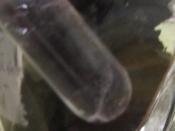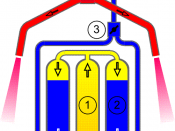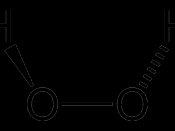The breakdown of hydrogen peroxide by the enzyme peroxidase is a common chemical reaction in cellular metabolism. However if the cells develops high amounts of hydrogen peroxide, it can harm the cell itself. There is a reaction within the liver that involves the hydrogen atoms in a toxic substance to bond with already existing oxygen molecules, this in turn forms hydrogen peroxide. The hydrogen peroxide is then neutralized by a specific interaction with the enzymes. Being that hydrogen peroxide is a common byproduct of the metabolism in cells, this process is often occurring. Animals have a large amount of this enzyme in there liver; this enzyme is called catalase. Plants also have vast amounts in specific areas where metabolic function is high; in plants its called peroxidase. Since we used a plant in this lab, we are dealing with peroxidase. In the lab we wanted to see what would happen if the peroxidase was isolated from the potato.
We observed a series of changes within the cells.
If the cells react in the experiment then strong reactions will occur while in contact with high concentrations of substrate and the enzyme, while lesser reactions will occur with the changing of temperature, with the least reaction with the changing of pH.
The following are some predictions: The enzyme will have an effect when introduced to changing concentrations of the enzyme. The enzyme will have a greater effect when introduced to changing concentrations of the substance. The enzyme will have a minimal effect when introduced into changing temperature. The enzyme will have the lowest effect when introduced into changing pH.
Enzyme concentration- Using 100, 80, 50, 20,and 0 ml of a pure enzyme solution we calculated the change of concentration of the enzyme by dipping a disc of filter paper into the buffer solution...


